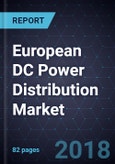Collaboration amongst OEMs, Distributed Energy Providers, and Governments is Critical for Implementing the DC Infrastructure
With the rising penetration of energy-consuming native direct current (DC) loads in commercial and residential applications, and the increasing focus on the adoption of energy-efficient systems to fulfil ambitious national goals, the debate over the relative merits of AC- versus DC- based systems has intensified. Whilst the DC power distribution market is growing at an accelerated pace, it is currently underpenetrated due to the existing AC infrastructure.
The DC power distribution market is expected to reach $40.1 million in 2025, driven by the increasing integration of solar PV and energy storage in residential and commercial buildings, combined savings opportunities from DC-powered LED lighting, and, to an extent, energy efficiency regulations and targets. However, the market is countered by a couple of strong barriers such as existing AC infrastructures and lack of DC-ready end-use products.
The market trends have been analysed for the study period of 2017 to 2025, with 2017 as the base year. The scope of the study includes components of DC power distribution systems in a DC/hybrid distribution network operating below 400V. The components include converters (central rectifiers and DC-DC converters), DC circuit breakers, DC power distribution units (PDUs), and DC power management systems (monitoring and control) installed for building-level, floor/room-level, and device-level conversion. The study does not include DC LED drivers and DC infrastructure components such as system connectors, power cable assemblies, and DC ceiling grids for market sizing.
The research has identified the most significant vertical markets and combined some verticals to make the research simple. These are commercial (includes office, retail, and hospitality), telecom sites, data centres, and “others” segments (includes industrial warehouses, healthcare, government buildings, infrastructure, and educational institutions).
The regional scope of the study covers Western, Northern, and Southern Europe as well as some of the larger markets of Central and Eastern Europe (CEE). Western Europe includes United Kingdom (UK) and Ireland, Germany, France, Netherlands, and Belgium; Southern Europe includes Iberia and Italy; Northern Europe includes Denmark, Norway, Finland, and Sweden; and Central and Eastern Europe includes Austria, Switzerland, Poland, and other Eastern European countries.
Key Issues Addressed
- What is the current state of the market and how strongly will it grow in the next five years?
- What are the DC end-use products that are currently available in the market?
- What are the different power distribution levels?
- What is the segmentation split?
- What are the current and future challenges that participants face in implementing DC power distribution in buildings?
- What are the growth opportunities and critical success factors for participants to fast-track growth in this market?
Table of Contents
Companies Mentioned (Partial List)
A selection of companies mentioned in this report includes, but is not limited to:
- ABB
- Armstrong
- Bosch
- Carling Technologies
- Cisco
- Cooper Lighting
- Creston
- Delta Power
- Eaton
- Legrand
- Leviton
- Lutron
- OSRAM
- Philips
- Schneider Electric
- Server Technology
- Siemens
- World Industries








